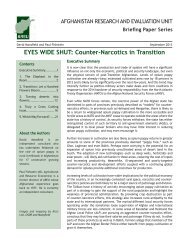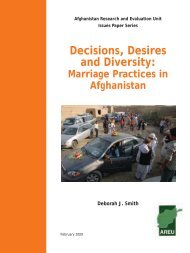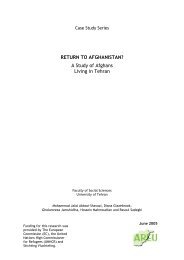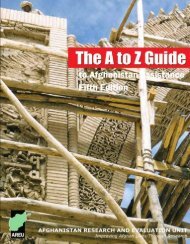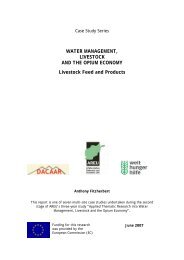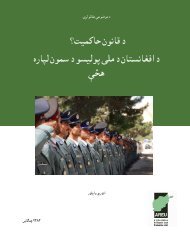Local Governance in Afghanistan: A View from the Ground
Local Governance in Afghanistan: A View from the Ground
Local Governance in Afghanistan: A View from the Ground
- No tags were found...
Create successful ePaper yourself
Turn your PDF publications into a flip-book with our unique Google optimized e-Paper software.
<strong>Afghanistan</strong> Research and Evaluation Unit<br />
2011<br />
draws attention to an emerg<strong>in</strong>g dynamic where boundaries between civil society organisations and<br />
fr<strong>in</strong>ge political groups are becom<strong>in</strong>g blurred. 102<br />
The evidence presented suggests that political parties are play<strong>in</strong>g an <strong>in</strong>creas<strong>in</strong>g significant role<br />
<strong>in</strong> Afghan politics. They have become more organised. Agendas have been articulated <strong>in</strong> party<br />
manifestos and party offices have sprung up <strong>in</strong> <strong>the</strong> unlikeliest of places. 103 Never<strong>the</strong>less, <strong>the</strong>re rema<strong>in</strong>s<br />
a persistent tension between nationally-organised parties and <strong>the</strong> control exercised by commanders<br />
and khans. In more stable environments, such as Samangan and Jawzjan, this was reflected <strong>in</strong> bribery<br />
and coercion by <strong>the</strong>se powerholders to achieve desired electoral ends. However, <strong>in</strong> areas that were<br />
more isolated or under <strong>the</strong> control of <strong>in</strong>dependent armed groups, this has resulted <strong>in</strong> <strong>the</strong> creation<br />
of personal fiefdoms and parallel <strong>in</strong>stitutions to replace state functions, as was observed <strong>in</strong> <strong>the</strong> west<br />
and southwest of Day Kundi.<br />
In Day Kundi, a number of ex-commanders and warlords have jo<strong>in</strong>ed political parties and ga<strong>in</strong>ed<br />
election to <strong>the</strong> prov<strong>in</strong>cial council, offer<strong>in</strong>g <strong>the</strong>m a way to formalise <strong>the</strong>ir power and co-opt weak<br />
government structures. For political parties, attach<strong>in</strong>g <strong>the</strong>mselves to such <strong>in</strong>formal but significant<br />
powerholders likewise provides a means to ga<strong>in</strong> political power and f<strong>in</strong>ancial resources. In Laghman,<br />
heads of certa<strong>in</strong> prov<strong>in</strong>cial and district l<strong>in</strong>e departments had close l<strong>in</strong>ks with <strong>the</strong> moderate w<strong>in</strong>g of<br />
HIA, 104 while o<strong>the</strong>rs were associated with <strong>the</strong> nationalist group Afghan Millat. Party priorities led<br />
members of l<strong>in</strong>e m<strong>in</strong>istries under HIA <strong>in</strong>fluence to actively underm<strong>in</strong>e <strong>the</strong> <strong>the</strong>n wali, who was alleged<br />
to be us<strong>in</strong>g his position to benefit <strong>from</strong> land deals. This tension was considerably resolved with<br />
<strong>the</strong> appo<strong>in</strong>tment of a new wali. In Wardak, party <strong>in</strong>fluence over government <strong>in</strong>stitutions has been<br />
coloured by <strong>the</strong> ethnic split between Pashtun districts and <strong>the</strong> two Hazara districts <strong>in</strong> <strong>the</strong> west. In <strong>the</strong><br />
Pashtun districts <strong>the</strong>re were HIA commanders engaged <strong>in</strong> anti-government activity with loose l<strong>in</strong>ks<br />
with <strong>the</strong> local Taliban. 105 Even <strong>in</strong> relatively peaceful Samangan, Jamiat and Junbesh commanders <strong>in</strong><br />
Dara-i-Suf Poyeen District exercised <strong>in</strong>fluence and control over government activities and refused to<br />
be disarmed.<br />
6.5 Non-state realm<br />
Civil society organisations (CSOs) have become <strong>in</strong>creas<strong>in</strong>gly relevant <strong>in</strong> <strong>the</strong> years s<strong>in</strong>ce 2001. Donor<br />
support to CSOs has led to <strong>the</strong>ir expansion <strong>in</strong> <strong>the</strong> large urban centres. However, few were active <strong>in</strong><br />
<strong>the</strong> prov<strong>in</strong>ces of this study. The anthropologist Thomas Barfield’s reference to <strong>the</strong> notion of a “civic<br />
space” is a more useful start<strong>in</strong>g po<strong>in</strong>t to understand<strong>in</strong>g <strong>the</strong> nature of civic engagement <strong>in</strong> <strong>Afghanistan</strong><br />
s<strong>in</strong>ce it <strong>in</strong>corporates <strong>the</strong> wealth of historical, cultural and spiritual traditions that form <strong>the</strong> basis<br />
for people’s actions and <strong>the</strong>ir engagement with society. 106 Moreover, a more pragmatic approach to<br />
understand<strong>in</strong>g <strong>the</strong> relationship between <strong>the</strong> state and civil society <strong>in</strong> Muslim cultures is emerg<strong>in</strong>g,<br />
which avoids see<strong>in</strong>g it as a phenomenon embedded <strong>in</strong> a given history or context. 107 The role of <strong>the</strong><br />
ulema <strong>in</strong> particular becomes extremely significant when seen through <strong>the</strong>se perspectives and is a<br />
subject for fur<strong>the</strong>r research.<br />
102 Anna Larson, “<strong>Afghanistan</strong>’s New Democratic Parties: A Means to Democratisation” (Kabul: <strong>Afghanistan</strong> Research and<br />
Evaluation Unit, 2009).<br />
103 Afghan Millat, a Pashtun nationalist party led by Anwar-ul-Haq Ahady (<strong>the</strong> current M<strong>in</strong>ister of Transportation and<br />
Industries), and Jamiat-i-Islami have been particularly enterpris<strong>in</strong>g <strong>in</strong> this regard. In 2009, Afghan Millat set up a party office<br />
<strong>in</strong> Nili, <strong>the</strong> prov<strong>in</strong>cial capital of Day Kundi.<br />
104 The moderate and militant w<strong>in</strong>gs of Hizb-i-Islami <strong>Afghanistan</strong> are Hizb-i-Islami Arghandiwal (led by Abdul Hadi<br />
Arghandiwal, current M<strong>in</strong>ister of Economy) and Hizb-i-Islami Gulbudd<strong>in</strong> (led by Gulbudd<strong>in</strong> Hekmatyar), respectively. Despite<br />
periodic <strong>in</strong>ternal tensions, both <strong>the</strong> moderate and militant w<strong>in</strong>gs of HIA are under <strong>the</strong> <strong>in</strong>fluence of Gulbudd<strong>in</strong> Hekmatyar.<br />
105 Reported by a representative of Harakat-i-Inquilab-i-Islami Milli <strong>Afghanistan</strong>, a smaller moderate-traditional political<br />
party that enjoys significant support <strong>in</strong> Wardak. It is led by Ahmad Nabi Mohammadi, son of former vice president and<br />
prom<strong>in</strong>ent jihadi commander Mohammad Nabi Mohammadi. Haji Musa Hotak, a member of <strong>the</strong> 2005 Wolesi Jirga, was until<br />
recently a member of <strong>the</strong> party. He has had l<strong>in</strong>ks with <strong>the</strong> Taliban and is now a member of <strong>the</strong> High Peace Council.<br />
106 “Br<strong>in</strong>g<strong>in</strong>g More Effective <strong>Governance</strong> to <strong>Afghanistan</strong>,” 52.<br />
107 Kaja Borchgrev<strong>in</strong>k, “Religious Actors and Civil Society <strong>in</strong> Post-2001 <strong>Afghanistan</strong>” (Oslo: International Peace Research<br />
Institute, 2007), 18.<br />
<strong>Local</strong> <strong>Governance</strong> <strong>in</strong> <strong>Afghanistan</strong>: A <strong>View</strong> <strong>from</strong> <strong>the</strong> <strong>Ground</strong><br />
49



